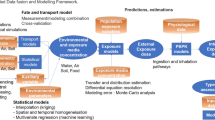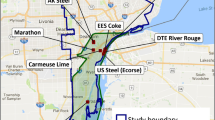Abstract
Deficiencies remain in current health impact assessment (HIA) and environmental impact assessment (EIA) projects. To address the shortcomings in EIA theory, a case of odors from a municipal sewage treatment plant (MSTP) was examined and geographic factors were employed to associate the spatial diffusion of the pollutants with the population’s activities based on land-use attributes. After screening the MSTP priority control pollutants, odors, hydrogen sulfide, and ammonia were selected for this study. Then, the spatial parameters for the pollutant simulation were surveyed, including parameters concerning the meteorological analysis, environmental emission monitoring, and emission source analysis, and a prediction of the pollutant diffusion as imaged and identified. The types of human social activity and exposure patterns were sorted as land-use attributes. An integration of the spatial diffusion of the pollutants with the exposure profiles of the scenario population according to the land-use attributes was achieved using counterpart spatial coordination factors. In our study, the commonly applied method of HIA risk calculation was followed and then extended by the spatial techniques introduced. The results of the scenario HIA contours are presented here, making it easy to determine the acceptable levels of the MSTP odor pollutants on a geographic scale. This study examines a significant approach to associate HIA with post-EIA via spatial factors and addresses the deficiencies of HIA in EIA empirical applications.







Similar content being viewed by others
Availability of supporting data
Not applicable.
References
Aliyu AS, Ramli AT, Saleh MA (2014) Environmental impact assessment of a new nuclear power plant (NPP) based on atmospheric dispersion modeling. Stoch Env Res Risk A 28(7):1897–1911
Arain MA, Blair R, Finkelstein N, Brook JR, Sahsuvaroglu T, Beckerman B, Zhang L, Jerrett M (2007) The use of wind fields in a land use regression model to predict air pollution concentrations for health exposure studies. Atmos Environ 41(16):3453–3464
Bai Z, Hu Y, Yu H, Wu N, Ding X, Zhu T (2007) Health risk assessment on citizens of inhalation exposure to environmental PAHs in Tianjin, China. international symposium on ambient air particulate matter:techniques and policies for pollution prevention and control
Bandosz TJ, Bagreev A, Adib AF, Turk A (2000) Unmodified versus caustics- impregnated carbons for control of hydrogen sulfide emissions from sewage treatment plants. Environ Sci Technol 34(6):1069–1074
Bari MA, Kindzierski WB (2018a) Ambient volatile organic compounds (VOCs) in Calgary, Alberta: sources and screening health risk assessment. Environmental Pollution s 631–632:602–614
Bari MA, Kindzierski WB (2018b) Ambient volatile organic compounds (VOCs) in Calgary, Alberta: sources and screening health risk assessment. Sci Total Environ 631-632:627–640
Bhatia R (2007) Protecting health using an environmental impact assessment: a case study of San Francisco land use decisionmaking. Am J Public Health 97(3):406–413
Boudet C, Zmirou D, Laffond M, Balducci F, Benoit-Guyod J-L (1999) Health Risk Assessment of a Modern Municipal Waste Incinerator. Risk Anal 19(6):1215–1222
Chanchitpricha C, Bond A (2018) Investigating the effectiveness of mandatory integration of health impact assessment within environmental impact assessment (EIA): a case study of Thailand. Impact Assess Proj Apprais 36(1):16–31
Chang IS, Yilihamu Q, Jing W, Wu H, Bo N (2017) Health impact assessment in environmental impact assessment in China: status, practice and problems. Environ Impact Assess Rev 66:127–137
Corburn J, Bhatia R (2007) Health impact assessment in San Francisco: incorporating the social determinants of health into environmental planning. J Environ Plan Manag 50(3):323–341
Demidova O, Cherp A (2005) Risk assessment for improved treatment of health considerations in EIA. Environ Impact Assess Rev 25(4):411–429
Du Z, Mo J, Zhang Y (2014) Risk assessment of population inhalation exposure to volatile organic compounds and carbonyls in urban China. Environ Int 73:33–45
Fehr R (1999) Environmental health impact assessment: evaluation of a ten-step model. Epidemiology 10(5):618–625
Gruchlik Y, Fouché L, Joll CA, Heitz A (2017) Use of alum for odor reduction in sludge and biosolids from different wastewater treatment processes. Water Environ Res 89(12):2103–2112
Harris P, Viliani F, Spickett J (2015) Assessing health impacts within environmental impact assessments: an opportunity for public health globally which must not remain missed. Int J Environ Res Public Health 12(1):1044–1049
Huang Y, Du W, Chen Y, Shen G, Su S, Lin N, Shen H, Zhu D, Yuan C, Duan Y (2017) Household air pollution and personal inhalation exposure to particles (TSP/PM2.5/PM1.0/PM0.25) in rural Shanxi, North China. Environ Pollut 231(Pt 1):635–643
Huang H, Lin C, Yu R, Yan Y, Li H (2019) Contamination assessment, source apportionment and health risk assessment of heavy metals in paddy soils of Jiulong River basin, Southeast China. RSC Adv 9(26):14736–14744
Ilten N, Selici AT (2008) Investigating the impacts of some meteorological parameters on air pollution in Balikesir, Turkey. Environ Monit Assess 140(1–3):267–277
Jianting YI, Zhang C, Feng XU, Luo C, Chen H, Zhao X (2015) The status and developing trend of municipal sewage treatment plants in China. Environmental Chemistry
Johnston L, Davison C, Lkhagvasuren O, Janes CR (2019) Assessing the effects of a Canadian-Mongolian capacity building program for health and environmental impact assessment in the mining sector. Environ Impact Assess Rev 76:61–68
Knibbs LD, Coorey CP, Bechle MJ, Marshall JD, Hewson MG, Jalaludin B, Morgan GG, Barnett AG (2018) Long-term nitrogen dioxide exposure assessment using back-extrapolation of satellite-based land-use regression models for Australia. Environ Res 163:16
Lamoreaux J, Arizona UO (2019) “Swimming in poison": reimagining endocrine disruption through China's environmental hormones. Cross-Currents: East Asian History and Culture Review 8
Lebret E (2015) Integrated environmental health impact assessment for risk governance purposes; across what do we integrate? Int J Environ Res Public Health 13(2):71
Lehtinen J, Veijanen A (2011) Determination of odorous VOCs and the risk of occupational exposure to airborne compounds at the waste water treatment plants. Water Sci Technol 63(10):2183–2192
Lei L, Hilton B (2012) Designing a Spatially Intelligent Framework to Improve Public Participation in the EIA Process for Renewable Energy and Power Transmission Projects. International Journal of Geo-Information 2(2):480–506
Lewkowska P, Cieślik B, Dymerski T, Konieczka P, Namieśnik J (2016) Characteristics of odors emitted from municipal wastewater treatment plant and methods for their identification and deodorization techniques. Environ Res 151:573–586
Liang K, Liu J (2016) Understanding the distribution, degradation and fate of organophosphate esters in an advanced municipal sewage treatment plant based on mass flow and mass balance analysis. Sci Total Environ 544:262–270
Liu C, Yang P, Liu X, Tang H (2017) Simulation analysis on odor dissipation and distribution characteristics of underground sewage treatment plant. Refrigeration and Air-Conditioning 17(1):79–87
Meng X, Venkatesan AK, Ni Y, Steele JC, Wu L, Bignert A, Bergman Å, Halden RU (2016) Organic contaminants in Chinese sewage sludge: a meta-analysis of the literature of the past 30 years. Environ Sci Technol 50(11):5454–5466
Minolfi G, Albanese S, Lima A, Tarvainen T, Rezza C, Vivo BD (2018) Human health risk assessment in Avellino-Salerno metropolitan areas, Campania region, Italy. J Geochem Explor 195:97–105
Niu Y, Chen R, Kan H (2017) Air pollution, disease burden, and health economic loss in China. Adv Exp Med Biol 1017:233–242
QEP, C. D. C. P. E, Victor JGPE, Ray HPE, Mark KPE, Neil WPE (2010) Odor investigation and control at a WWTP in orange county, Florida. Environ Prog Sustain Energy 20(3):133–143
Rajiv B, Aaron W (2008) Integrating human health into environmental impact assessment: an unrealized opportunity for environmental health and justice. Environ Health Perspect 116(8):991–1000
Ren B, Zhao Y, Lyczko N, Nzihou A (2018) Current status and outlook of odor removal Technologies in Wastewater Treatment Plant. Waste Biomass Valor:1–16
Rouéle GA, Jabot F (2018) Health impact assessment on urban development projects in France: finding pathways to fit practice to context. Glob Health Promot 24(2):25
Ruby MV, Schoof R, Brattin W, Goldade M, Post G, Harnois M, Mosby DE, Casteel SW, Berti W, Carpenter M (1999) Advances in evaluating the Oral bioavailability of inorganics in soil for use in human health risk assessment. Environ Sci Technol 33(21):3697–3705
Sabetghadam S, Ahmadigivi F (2014) Relationship of extinction coefficient, air pollution, and meteorological parameters in an urban area during 2007 to 2009. Environ Sci Pollut Res Int 21(1):538–547
Spickett J, Katscherian D, Goh YM (2012) A new approach to criteria for health risk assessment. Environ Impact Assess Rev 32(1):118–122
Valeberg BT, Hanestad BR, Klepstad P, Miaskowski C, Moum T, Rustøen T (2009) Human health and wellbeing in EIAs in New South Wales, Australia: auditing health impacts within environmental assessments of major projects. Environ Impact Assess Rev 29(5):310–318
Vu VH, Le XQ, Pham NH, Hens L (2013) Application of GIS and modelling in health risk assessment for urban road mobility. Environ Sci Pollut Res 20(8):5138–5149
Wang Z (2013) Characteristics and simulation of hydrogen sulfide emission in a municipal wastewater treatment plant. (in chinese). Tsinghua University Press, Beijing
Wang H, Lv S, Diao Z, Wang B, Zhang H, Yu C (2018a) Study on sandstorm PM 10 exposure assessment in the large-scale region: a case study in Inner Mongolia. Environ Sci Pollut Res Int 25(17):17144–17155
Wang J, Tian Z, Huo Y, Yang M, Zheng X, Zhang Y (2018b) Monitoring of 943 organic micropollutants in wastewater from municipal wastewater treatment plants with secondary and advanced treatment processes. J Environ Sci 67(5):309–317
Zhou J, You Y, Bai Z, Hu Y, Zhang J, Zhang N (2011) Health risk assessment of personal inhalation exposure to volatile organic compounds in Tianjin, China. Sci Total Environ 409(3):452–459
Acknowledgments
The authors are extremely grateful to the staff at the Department of Environment and Health for their health statistics technical guides. The findings and conclusions in this report are those of the authors. The authors declare that they have no competing financial interests.
Authors’ information
Not applicable.
Funding
The research presented here was supported by Chinese Ministry of Science and Technology Project 2018YFC0213704.
Author information
Authors and Affiliations
Contributions
The authors’ responsibilities were as follows—Hongmei Wang is the PI of the parent project and obtained funding and supervised all scientific aspects of the work; Huifeng Wang, Ci zhao, Xiang Huang, and Zhanlu Lv formulated the research questions and designed the study and mediation analysis; Xiaoyu liu designed data protocols and collected data; Xiang Huang provided essential materials; Ci zhao handled all statistical programing and analysis; Zhanlu Lv interpreted results; Hongmei Wang wrote the paper; Hongmei Wang had primary responsibility for final content. All authors read and approved the final manuscript.
Corresponding author
Ethics declarations
Consent for publication
Not applicable.
Ethical approval and consent to participate
No applicable.
Competing interests
The authors declare that they have no competing interests.
Additional information
Publisher’s note
Springer Nature remains neutral with regard to jurisdictional claims in published maps and institutional affiliations.
Highlights
An approach integrating health impact assessment (HIA) and environmental impact assessment (post-EIA) is developed.
A pollutant diffusion simulation is linked to a scenario population’s exposure parameters assigned to land-use attributes.
Rights and permissions
About this article
Cite this article
Wang, H., Wang, H., Zhao, C. et al. Linking health impact and Post-environmental impact assessments: a case of municipal sewage treatment plant volatile organic compounds. Air Qual Atmos Health 13, 421–433 (2020). https://doi.org/10.1007/s11869-020-00805-x
Received:
Accepted:
Published:
Issue Date:
DOI: https://doi.org/10.1007/s11869-020-00805-x




